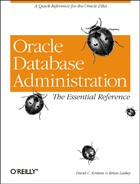Hot or Cold Backups
The following scenarios are designed to allow you to gain experience and comfort recreating the database from backups. They are presented in order of increasing complexity.
Recover the database from a full cold backup:
Recover a single datafile.
Recover the entire database.
Put the database in archivelog mode and then perform a hot backup:
Create a table in a tablespace with only one datafile. Then insert one or more rows.
Perform enough ALTER SYSTEM SWITCH LOGFILE commands to cycle through all redo logs.
Shut down the instance (optional).
Delete the datafile containing the created table.
Restore the datafile from the hot backup.
Perform media recovery on the datafile. Then verify that the database requested at least one archive file.
Verify that the table was recreated and has all the information required.
If you have a backup tool that performs incremental hot backups (e.g., some third-party tools and Oracle8 Recovery Manager), do the following:
Take a hot backup.
Create a table; then insert one or more rows. Place the table in a tablespace with only one datafile.
Perform an incremental backup. Then verify that portions of the datafile were backed up.
Perform enough ALTER SYSTEM SWITCH LOGFILE commands to cycle through all redo logs.
Stop the database (optional).
Delete the datafile containing the created table.
Use your restore utility to restore the table. Then verify not only that the original hot backup was restored, but also that the incremental backup was restored.
Perform media recovery. Then verify that at least one archive file is required.
Verify that the table was recreated and has all the information required.
Test tablespace point-in-time recovery by doing the following:
Take a hot backup.
Create a table; then insert one or more rows. Place the table in a tablespace with only one datafile.
Create an index on the table in another tablespace that will not be recovered.
Take note of the time for tablespace point-in-time recovery.
Create another table. Then insert more rows in the first table.
Use the tablespace point-in-time recovery process to create a clone database as of the time noted in step d.
Note that the second table is listed in the TS_PITR_OBJECTS_TO_BE DROPPED data dictionary view.
Note that the index created in step c is listed in the TS_PITR_CHECK data dictionary view.
Complete the tablespace point-in-time recovery.
Verify that the second table and the rows added in step e are no longer in the database.
